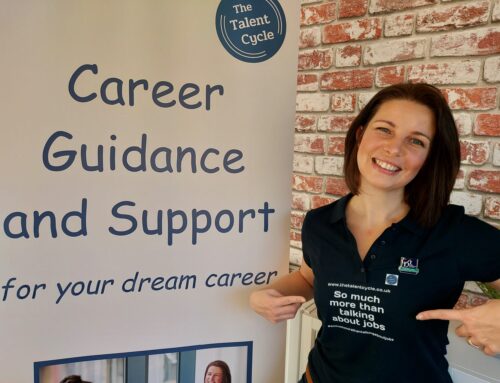Despite what the title might suggest, this article is not aimed solely at careers leaders and careers advisers working in special schools or other alternative educational settings. Special educational needs and disabilities (SEND) are found across all sections of society and in all educational settings. Sometimes there are identified special educational needs, confirmed by a formal diagnosis and possibly also an Education, Health and Care (EHC) plan, but sometimes individuals can have forms of SEND that are less visible than others and can go undetected for a long time. In this sense, all career development professionals are career development professionals for SEND, as it is highly likely that all will encounter young people with SEND in their careers, knowingly or otherwise.

What is SEND? Listen to the student
According to the Government’s SEND Code of Practice, ‘A child or young person has SEN if they have a learning difficulty or disability which calls for special educational provision to be made for him or her’.[1] The broad areas of need as defined by the Code of Practice include:
- Communication and interaction (e.g. speech, language and communication needs; autism).
- Cognition and learning (e.g. specific learning difficulties such as dyslexia or dyspraxia; moderate, severe, and profound and multiple learning difficulties).
- Social, emotional and mental health difficulties (e.g. mental health difficulties, substance misuse, attachment disorder, ADHD).
- Sensory and/or physical needs (e.g. sensory impairments, physical disabilities).[2]
As we can see, SEND covers a very wide range of different needs and is not necessarily related to academic ability. It is the responsibility of a career development practitioner to gather information about a student’s or client’s needs as much as possible to help inform any adaptations that they will need during the guidance process. In a school or college base setting, a student may have an EHC plan or an Individual Education Plan (IEP), possibly supported by reports from other professionals. The school or college Special Educational Need Coordinator (SENCO) will be a great source of information, as will the student’s parents or carers. Above all, however, it is vital to speak to students and clients to find out direct from them how they experience their SEND, and what support or adaptations they feel they will need. This is essential, as whatever their diagnosis or whichever category of SEND they fall within, no form of SEND is experienced identically by all individuals who experience it.
Adapting practice
Schools and education authorities have had a duty to provide reasonable adjustments for disabled students since 2002, reinforced by the Education Act 2020. In the context of career education and guidance, this means that the delivery of careers services must be done in a way that takes account of that person’s needs and does not discriminate against them in any way. The information gathering mentioned above is vital to this, as the SEND Code of Practice makes it clear that the duty to make reasonable adjustments ‘is anticipatory – it requires thought to be given in advance to what disabled children and young people might require and what adjustments might need to be made to prevent […] disadvantage’.[3] So while the fundamental aim of career education and guidance for young people with SEND will be the same as for any other young person – to enable them to make sense of their situation and their options and hopefully make a successful transition to the next stage of their learning or work journey – careers leaders and advisers will need to adjust their usual ways of delivering this.
What reasonable adjustments are made will depend on the individual’s needs and specific situation. In educational settings, the SENCO should be able to offer specific advice around what specific adjustments are needed, but the young person should always be included in this conversation as much as possible. It may be that the room layout will need to be adjusted to be made more accessible for young people with physical disabilities and/or those with sensory difficulties. Students with autism and those with processing difficulties may need more time to process questions and to formulate their responses, so careers professionals need to be comfortable with longer silences in guidance interactions and be ready to check understanding and offer clarification when needed. Some types of SEND make it more difficult for people to process metaphorical or complex language, so it is important to be attentive to the choice of vocabulary used. Others may find it difficult to cope with a standard 45-minute career guidance interview, perhaps because of anxiety, sensory needs, or just their capacity to sustain attention for that length of time. In such circumstances a careers professional might need to stagger the guidance process over a series of smaller interactions. Also, some young people with SEND will respond better to visual or kinaesthetic activities and approaches – having access to a ‘fiddle toy’ can help sustain engagement in guidance activities as in other learning situations, for example – and the format of the action plan might need to be adjusted too. Below is an example of a visual ‘mind map’ career guidance action plan developed by David Roe at the South West based company CSW Group for use with young people with moderate learning difficulties:

There is no set-in-stone ‘blueprint’ here in terms of which reasonable adjustments will need to be made for any given student. The guiding principles are that career guidance for SEND is not always ‘business as usual’, that adjustments to practice will often need to be made in order for the service offered to be equitable and accessible, and the nature of these adjustments will depend on the type of SEND and the individual concerned.
Collaboration
The Careers and Enterprise Company’s excellent guide Transition programmes for young people with SEND outlines a range of principles for good practice, including interagency collaboration and also family involvement.[4] Young people with SEND often face a complex transition from one educational setting to another, or from an educational setting into the workplace. Some of the factors included in such a transition include helping the young person (and often their parents or carers) prepare for an upcoming change in their circumstances, consultation with the new setting (whether this is an educational setting, a workplace, or some combination of the two), forward planning to ensure that reasonable adjustments are put in place, and other factors such as working out the logistics of travel arrangements, etc.
Given the multiple factors that need to be taken into account here, careers professionals need to be comfortable with multi-agency working. Other important professionals who may play an important part in any career-related transition include educational psychologists, occupational therapists, local authority SEN teams, social workers, charities and others. A series of multi-agency meetings may be appropriate in order to ensure that everyone supporting the young person is working coherently and in a joined-up fashion. Keeping the views and feelings of the young person and their family central to this process is key throughout, as this ensures that the process remains client-centred and also recognises the irreplaceable expertise that families can often impart in terms of understanding their children’s needs, including outside of an educational setting.
Don’t assume!
It can be very easy to fall into the trap of making assumptions about the capacity of young people with SEND and interpret their needs in terms of limitations rather than capacities. This is something that any career development professional will want to avoid in keeping with the general thrust of the Equality Act 2010, the SEN Code of Practice, but also with the Career Development Institute’s Code of Ethics.[5]
Society places many barriers in the way of people with SEND. Career development professionals are uniquely placed to challenge such barriers and provide a key role in assisting individuals with SEND in articulating their potential and helping educational institutions and employers recognise this. Some of the barriers that people with SEND experience when they try to advance their careers are based on a misunderstanding of the nature of their needs and their capacities. Acting as an advocate, a careers professional can help articulate the potential benefits of training or employing a young person with SEND. They can also help educational establishments and employers understand what they can do to remove obstacles preventing these young people from being valued and productive learners and employees.
A professional attitude of open mindedness and collaboration is key to delivering any kind of successful career education or guidance intervention. Case studies of young people with SEND – including school and college alumni – can be powerful tools in helping young people recognise their potential and their capacity to achieve career goals as fulfilling as any of their peers.
[1] Department for Education and Department for Health. (2015). Special Educational Needs and Disability Code of Practice: 0 to 25 Years. Statutory Guidance for Organisations which Work with and Support Children and Young People who have Special Educational Needs or Disabilities. UK: Department for Education, p. 25.
[2] Ibid., pp. 97-99; see also Jill Hanson, Geraldine Codina, and Siobhan Neary. (2017). Transition programmes for young adults with SEND. What works? London: The Careers and Enterprise Company, p. 10.
[3] Department for Education and Department for Health., p. 17.
[4] Hanson et al., p. 7.
[5] Career Development Institute. (2019). Code of Ethics. Available from CDI Codes of Ethics (thecdi.net).
Bibliography
Career Development Institute. (2019). Code of Ethics. Available from CDI Codes of Ethics (thecdi.net).
Department for Education and Department for Health. (2015). Special Educational Needs and Disability Code of Practice: 0 to 25 Years. Statutory Guidance for Organisations which Work with and Support Children and Young People who have Special Educational Needs or Disabilities. UK: Department for Education.
Hanson, Jill, Geraldine Codina, and Siobhan Neary. (2017). Transition programmes for young adults with SEND. What works? London: The Careers and Enterprise Company.
Oliver Jenkin is a Career Development Consultant at CSW Group with 11 years’ experience helping young people bring about positive changes in their educational and working lives. Oliver is a registered member of the Career Development Institute.





